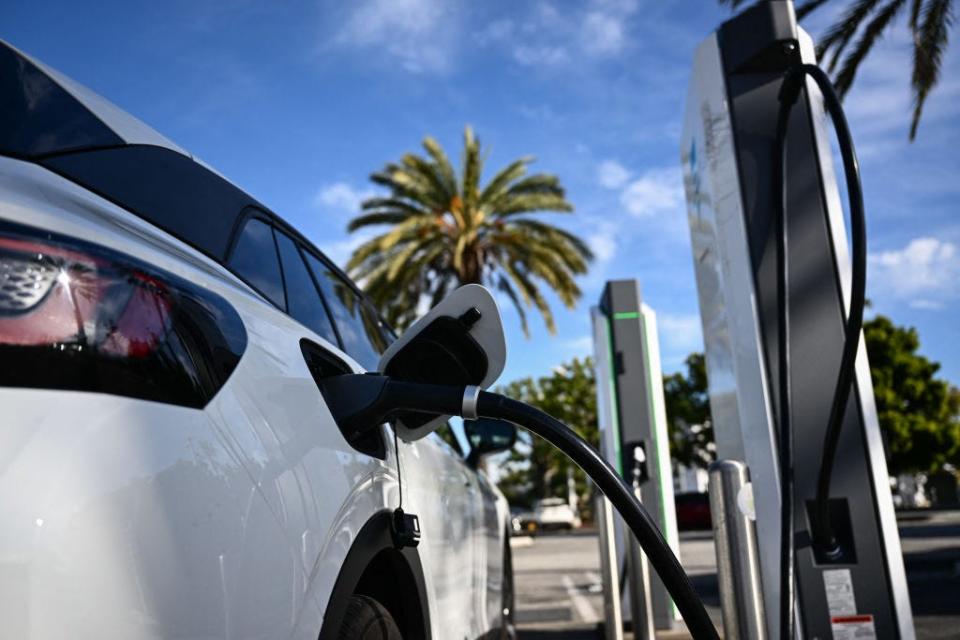EV range is making huge strides, but there still aren't enough places to charge.

EVs go a lot farther these days, but chargers are still hard to find.
No one seems to agree whose job it is to build charging infrastructure.
Building enough chargers is just one part of the problem.
Electric vehicles have come a long way — literally.
In the earliest days of the EV transition, a fully battery-powered car (like the first-generation Nissan Leaf that went on sale in 2010) could only drive for about 100 miles on a full charge in the best weather conditions.
That's fine for an enthusiastic early adopter or someone looking to replace just one of their multiple gas cars, but it didn't satisfy the average car shopper.
Today, a mass-market EV can deliver about 300 miles on a single charge. That's a huge improvement in just 14 years, but the great American road trip is still far from achievable in an EV, thanks to one persistent issue: range anxiety.
Car companies and battery suppliers have spent years working to quell this anxiety. But despite the vast improvements in battery technology, EV charging still can't hold a candle to the 5-minute stop to fill a gas tank.
Even as charging times come down (GM boasts its Ultium batteries can gain about 100 miles of range in 10 minutes on a DC fast charger), there simply aren't enough public chargers in the right spots.
Car companies hoped the public charging infrastructure would improve along with them as they built more range into their vehicles. This hasn't really happened, though, and a slew of EVs are hitting the market with nowhere to charge up on a road trip, exacerbating one of the biggest barriers to adoption.
Charging is a hot potato issue
One thing essentially everyone can agree on in the EV transition is that vast and reliable fast-charging infrastructure is essential. Studies have shown that areas with more access to public charging infrastructure have higher rates of EV adoption, even though a majority of charging happens at home.
What no one can seem to agree on is who is responsible for building out public charging infrastructure. And a closer look reveals that perhaps pinning the problem on one entity, public or private, will only slow efforts to grow.
Car companies have made some efforts to build out charging infrastructure, partnering with charging companies and other stakeholders to install public chargers and help new EV buyers install home charging systems.
Tesla, which has always led the way with its Supercharger network, is also opening its stations to other car manufacturers, aiding in patching the holes in the public charging network.
All these industry efforts have helped to feed an EV charging infrastructure boom in recent years. At the start of 2024, there were some 61,000 public charging stations in the US, more than doubling the amount of stations there were in 2020, according to Pew Research and the Department of Energy.
Still, that's way less than the roughly 120,000 gas stations nationwide, and public efforts to grow charging infrastructure appear to be slow-going so far.
The Biden Administration has set aside $7.5 billion for charging infrastructure with a vow to add 500,000 EV charging stations by 2030. Since Congress approved this funding two years ago, only a handful of stations have gone live, according to reports.
Building out charging infrastructure is just one piece of the puzzle
We're still far from the level of infrastructure required for mass adoption, even as the rate of EV sales hits a slowdown.
One slowdown appears to feed the other: a new crop of EV shoppers isn't interested in buying a car that might die on a road trip, and charging companies aren't willing to grow for customers that don't exist yet.
On top of the issue of infrastructure coverage, there is the question of where we will get the power to run all of these new charging stations.
A recent study from the University of Michigan Transportation Research Institute found that utilities are not fully equipped to handle the large swings in usage that can be caused by increased amounts of EV charging.
All this means that cross-industry efforts — between car companies, their suppliers, charging startups, and public utilities — will be crucial as we continue to grow the share of electric cars on the road.
Read the original article on Business Insider

 Yahoo Autos
Yahoo Autos 